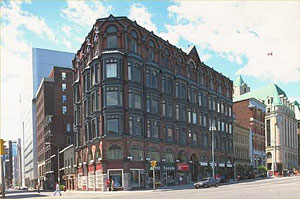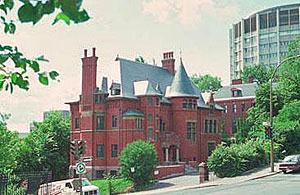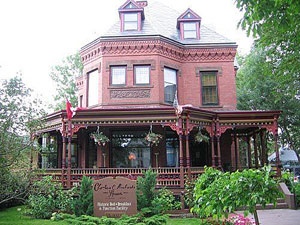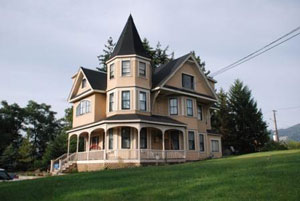The Queen Anne Revival Style
What is Queen Anne Revival? It is an architectural style
that has very little to do with the English monarch Queen Anne or
the style of buildings constructed during her reign, which lasted
from 1702 to 1714. The Queen Anne Revival is from the late
Victorian era, and was most popular between 1890 and 1914. It
drew its inspiration from different eras and incorporated many
things into its designs. Occasionally referred to as "free
Renaissance," the builders of Queen Anne Revival buildings
generally focused on asymmetrical facades, steeply-pitched and
irregular rooflines, front-facing gables, overhanging eaves,
circular or square towers with turrets in corners, unusual windows,
wraparound verandas, highly ornamented spindles, fish scale siding,
detailed textures and bright colours.
The style is difficult to define due to its eccentricities, and
has been described as being exuberant and excessive, fanciful and
flamboyant in outlook. Though falling out of fashion in the
first decades of the 20th century, the style seems to
have made a comeback in popularity, perhaps because its iconic and
accessible Victorianism has ingrained itself in the public
consciousness.
 Many Canadian historic places were
designed in the Queen Anne Revival style. For example, a well-known
Ottawa landmark, the Central Chambers National Historic Site (NHS)
of Canada is an excellent example of a Queen Anne
Revival commercial building. This six-storey building was
designed by Ottawa architect J. J. Browne for commercial and office
space.
Many Canadian historic places were
designed in the Queen Anne Revival style. For example, a well-known
Ottawa landmark, the Central Chambers National Historic Site (NHS)
of Canada is an excellent example of a Queen Anne
Revival commercial building. This six-storey building was
designed by Ottawa architect J. J. Browne for commercial and office
space.
Central Chambers is located at the edge of the high profile Confederation Square NHS in Ottawa's
downtown core. Its rich colouration of materials includes red
brick, terra cotta, white trim, and metal. This accentuates
the surfaces and textures that are an important feature of the
Queen Anne Revival style. Central Chambers also
features a variety of windows, including ones of massive size at
ground level that helped maximize merchandise displays and
served to light office interiors. Although other Queen
Anne Revival commercial buildings exist
in Canada, Central Chambers has one of the most
distinctive and exceptional designs for the era. 
Of the many Queen Anne Revival houses, Montréal's two-and-a-half
storey H. Vincent Meredith Residence NHS stands
apart. Situated within the "Golden Square Mile," this house
was built in 1897 for Andrew Allen, a partner in the influential
Allen Steamship Company. An over-the-top architectural gem,
it features a steep hipped roof with dormers and tall chimneys, a
high, irregularly-shaped roofline, a whimsical composition, and a
mixture of Venetian and lancet windows, and a round tower with
conical roof. This massive structure with its highly visible
location on the side of a hill was designed to be a showy
manifestation of late 19th century optimism, new wealth
and power.
 Another exceptional Queen Anne Revival
home is the Charles Richards House in Yarmouth, Nova
Scotia. This place is significant because it is one of only
two brick Queen Anne Revival houses in Nova Scotia. Located
within the Collins Heritage Conservation District, the
house rises two-and-a-half storeys, is dominated by beautiful red
brick, has an asymmetrical facade with a wrap-around veranda, a
two-storey bay window, and steeply pitched roof. Also worth
noting are the veranda posts with spindlework ornamentation and
decorative brackets, as well as the unusual brickwork under the
eaves.
Another exceptional Queen Anne Revival
home is the Charles Richards House in Yarmouth, Nova
Scotia. This place is significant because it is one of only
two brick Queen Anne Revival houses in Nova Scotia. Located
within the Collins Heritage Conservation District, the
house rises two-and-a-half storeys, is dominated by beautiful red
brick, has an asymmetrical facade with a wrap-around veranda, a
two-storey bay window, and steeply pitched roof. Also worth
noting are the veranda posts with spindlework ornamentation and
decorative brackets, as well as the unusual brickwork under the
eaves.
On the West Coast, the Campbell House in Vernon, British
Columbia displays a modification of the more traditional Canadian
Queen Anne Revival  style. Influenced by American
Queen Anne Revival patterns, the builder of this house used
fish-scale shingles, drop siding, and bay windows. Also, this
is a wood frame structure, not brick. Yet it remains a
conventional Queen Anne home, adopting elements such as a corner
tower with a turret, double hung windows and decorative gables,
large gables, and extensive verandas. Built in 1898, this visually
eccentric house was owned for many years by the Campbell family,
who operated a furniture store and a funeral business in
Vernon. This is the kind of house people might also now
associate with a haunting Victorianism popularized in media culture
since the release of Alfred Hitchcock's 1960 film
Psycho.
style. Influenced by American
Queen Anne Revival patterns, the builder of this house used
fish-scale shingles, drop siding, and bay windows. Also, this
is a wood frame structure, not brick. Yet it remains a
conventional Queen Anne home, adopting elements such as a corner
tower with a turret, double hung windows and decorative gables,
large gables, and extensive verandas. Built in 1898, this visually
eccentric house was owned for many years by the Campbell family,
who operated a furniture store and a funeral business in
Vernon. This is the kind of house people might also now
associate with a haunting Victorianism popularized in media culture
since the release of Alfred Hitchcock's 1960 film
Psycho.
Although many Queen Anne Revival buildings are found in
residential areas, the style is not limited to  homes. For example, Earl Grey School in downtown Winnipeg is
a wonderful example of an institutional structure with Queen Anne
Revival elements. Instead of using the traditional red brick,
architect James B. Mitchell chose salmon-coloured bricks.
This three-storey building has varied dormers and two projecting
four-storey square towers which contribute to its interesting
asymmetrical facade. Decorative floral medallions can be
found on the institutional inscription "The Earl Grey School,"
which are characteristic of Queen Anne Revival
ornamentation.
homes. For example, Earl Grey School in downtown Winnipeg is
a wonderful example of an institutional structure with Queen Anne
Revival elements. Instead of using the traditional red brick,
architect James B. Mitchell chose salmon-coloured bricks.
This three-storey building has varied dormers and two projecting
four-storey square towers which contribute to its interesting
asymmetrical facade. Decorative floral medallions can be
found on the institutional inscription "The Earl Grey School,"
which are characteristic of Queen Anne Revival
ornamentation.
Queen Anne Revival buildings are an important part of our
Canadian architectural heritage. As we can see, the Queen
Anne Revival style moved away from the sober classical decoration
of earlier eras and instead promoted more flexible natural designs
such as sunbursts and flower patterns, and the houses were either
painted vibrant colours or had richly hued brickwork to emphasize
the ornate details and textures. The style is filled with
exuberance, variation and asymmetry. Though it fell out of
fashion after 1914, it is worth noting that most of the original
buildings have endured, and the style has again grown in
popularity, even to the point where new houses in modern
subdivisions are being constructed with a nod to Queen Anne
Revival's more whimsical features. There are hundreds of
designated Queen Anne Revival buildings on the Canadian Register of
Historic Places, and as part of our cultural heritage, they help
reflect Canada's hopeful and joyful expansion in the late
19th and early 20th centuries.